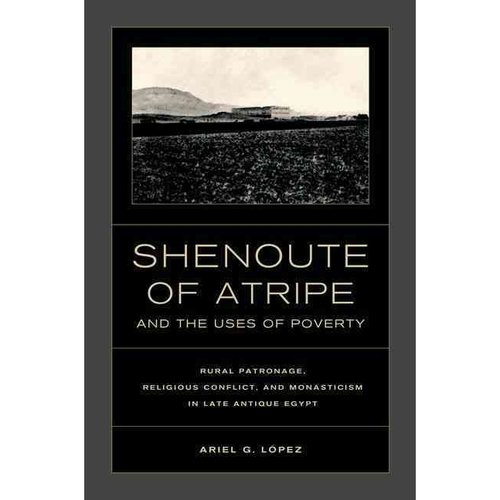Ariel G. López. Shenoute of Atripe and the Uses of Poverty: Rural Patronage, Religious Conflict, and Monasticism in Late Antique Egypt. Transformation of the Classical Heritage Volume 50. Berkeley, CA: University of California Press, 2013. 237 pgs. Hardback. $81.92. ISBN: 9780520274839.
Shenoute of Atripe and the Uses of Poverty is the publication of López’s (revised) doctoral dissertation, defended at Princeton University in 2010. (ix) The work consists of seven main parts, including a substantial introduction, four core chapters, a concise conclusion, and appendices. López places the work in the field of late antique ‘social history,’ but because of the new translations of Shenoute’s Coptic writings, also builds on the fields of papyrology and Coptology. (x)
In the introduction, López shows how Shenoute’s social context and the developments concerning social audacity in fifth century Egypt (but also the Roman Empire at large) enable the abbot Shenoute to ‘rise to public prominence.’ (3) During Shenoute’s tenure (CE: 407?-466), the classical or traditional relationship between farmer and landowner, taxer and the taxed, but also the relation between villages, gradually changed. Villages started to ‘misbehave’ and refuse to pay the taxes they owed. Lower classes started to rebel against the higher classes and question their authority. López calls this phenomenon the growth of ‘rustic audacity.’ (4-11) In this work, López argues that Shenoute employed this development in an attempt to get a foothold in the politics of his region and is, as such, a great example of how this ‘rustic audacity’ functioned in society. Shenoute placed himself on the side of the poor; they were being oppressed by the rich and he saw it as his task to plead for their well-being. López posits that the polemic between Shenoute as the representative of the poor and Gesios of Panopolis as personification of the rich, facilitates Shenoute’s rise as a prominent public figure. The tractates, letters and treatises associated with this polemic will, therefore, be the main source of this study. (11-15)
López uses the antithetic nature of the polemic as a guideline for his four core chapters. The first chapter—named ‘Loyal Opposition’—concerns the political ‘friend-enemy’ antithesis. (19-45) López, in the first part of the chapter, elucidates how Shenoute’s self-representation as an angry, volatile man and use of strong language, first, were crucial to be noticed by the rich in Panopolis and needed to provoke a response. Second, his self-representation as advocate of the poor “allowed him to be deeply involved in the life of Panopolis.” (26) Hereafter, López illustrates how this sharp distinction between the poor and Shenoute on the one hand, and those who oppress the poor on the other (a) clarifies his relation with and opinion of the Roman state regarding its responsibility to take care of the poor, (b) shows what the difference is between Shenoute’s ‘just’ parrhesia against the rich and the violence of the rich towards the poor and (c) forces Shenoute to defend his place in the monastery as a poor abbot whilst at the same time participating in political discussions.
The second and third chapters, respectively called ‘A Miraculous Economy’ and ‘Rural Patronage: Holy and Unholy,’ focus on the ‘economic antithesis.’ In the second chapter, López outlines the considerable affluence and prosperity of Shenoute’s federation and the source of this surplus ‘miraculous wealth.’ To justify the huge amounts of money received and accepted by the monastery, Shenoute had to, first, emphasize all the good works they did and show how much money they spent on supporting the poor and, second, characterise those gifts as blessings from God (46-72). The following chapter tries to relate this wealth to Shenoute’s denunciation of the rich and their violence (73-101). The last chapter, describing the ‘Christianity-paganism antithesis,’ hopes to explicate how Shenoute defends his attitude and violence towards the ‘old’ pagan religions in his vicinity. It meticulously analyses Shenoute’s attacks on the aforementioned pagan, Gesios (102-126).
Ariel López’s work is part of the recent ‘revival’ of Shenoute-scholarship. The majority of more recent scholarly work (e.g.: Krawiec 2002, Schroeder 2007 and Davis 2008) on Shenoute focusses on the functioning of his monastic federation, the uniqueness of his rules and how to position him theologically in the wider theological debates. López has systematically shown how Shenoute positioned himself in relation to his surrounding political and social situation, and how he exploited the changing relationship between the classes. The writer has been able to frame the negative associations with Shenoute’s character (Leipoldt 1903, Bell 1982 etc.) and show how they serve a certain purpose—defending and protecting the poor against the rich of his time.
In conclusion, López has succeeded in providing a convincing argument. I wonder, though, whether Shenoute’s sharp tone is the result of a pragmatic desire to gain notice and recognition for himself or whether, in line with James E. Goehring’s position (Keeping the Monastery Clean, 2007), he has this strict attitude and harsh tone based on a certain ascetic ideology/theology. Further investigation into the relation of Shenoute’s rhetoric regarding the poor and his asceticism/ascetic theology might give another dimension to the connection of the political and monastic life of this Coptic abbot.
The Bottom Line: Ariel López’s Shenoute of Atripe and the Uses of Poverty convincingly places Shenoute in his smaller Egyptian and larger Roman late antique context, which helps the reader of Shenoute to better understand the nature and goal of some of his exhortations concerning unfaithfulness and the wellbeing of the poor.
Johannes J. Knecht (johannesjknecht@gmail.com)
University of St Andrews





Leave a Reply
Your email is safe with us.